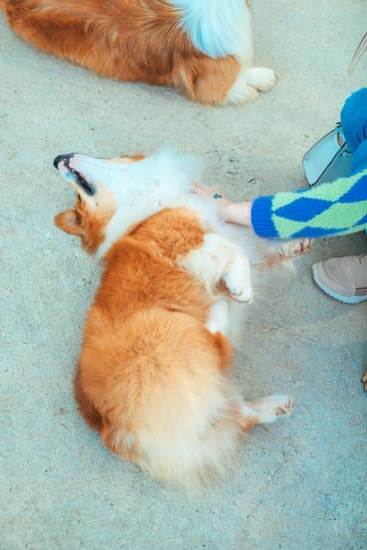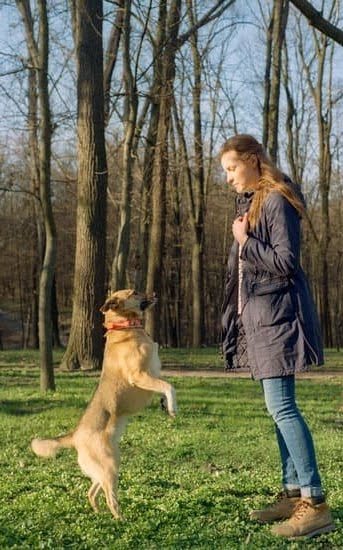Are you wondering how to train a small dog to point? Pointing behavior in dogs, commonly seen in hunting breeds, involves the act of freezing and directing their gaze towards prey. This instinctual behavior can be honed and developed in small dog breeds through proper training techniques.
Understanding the natural pointing behavior in dogs is crucial before embarking on training sessions. Pointing is a form of communication between the dog and their owner, indicating the presence of game or prey. By recognizing this behavior, owners can effectively train their small dogs to point and assist them in various activities, including hunting or simply engaging in fun exercises.
In this article, we will explore the importance of pointing behavior in small dogs, discuss how to choose the right breed for training, and provide tips on creating a suitable environment for pointing exercises. Additionally, we will delve into teaching basic obedience commands, introducing visual aids for pointing training, incorporating scent training, and implementing progressive techniques to help small dogs master the art of pointing.
Why Pointing Behavior Is Important in Hunting Dogs
The pointing behavior in hunting dogs is a crucial skill that can make a significant difference in the success of a hunting expedition. When a dog points, it freezes in place with its nose and tail level, indicating the presence of game nearby. This behavior allows hunters to approach stealthily and prepare for a successful shot. Training small dogs to point can be challenging but rewarding, as even pint-sized pups can excel in this skill with the right guidance.
To train a small dog to point effectively, it is essential to understand the breed’s natural instincts and tendencies. Breeds such as English Setters, Pointers, Brittany Spaniels, and German Shorthaired Pointers are known for their pointing abilities. However, even small breeds like Dachshunds or Jack Russell Terriers can be trained to point with patience and consistency.
Here are some key steps on how to train small dogs to point:
- Start by establishing a strong foundation of basic obedience commands such as sit, stay, and come.
- Introduce visual aids such as bird wings or feathers on sticks during training sessions to simulate the sight of game.
- Incorporate scent training by using bird scent or other game scents to help your small dog associate the smell with the act of pointing.
By following these steps and gradually building upon them with progressive training techniques, you can help your small dog develop reliable pointing skills that will impress both in hunting scenarios and everyday activities. Remember that each dog is unique, so be patient and adjust your training methods accordingly to suit your canine companion’s learning style. Celebrate every milestone and success along the way to reinforce positive behavior and create a strong bond with your small hunting partner.
Choosing the Right Small Dog Breed for Pointing Training
When it comes to training a small dog to point, choosing the right breed is an essential first step. Not all small dog breeds are naturally inclined to pointing behavior, so selecting a breed known for its hunting instincts is key. Breeds such as the English Setter, Brittany Spaniel, and German Shorthaired Pointer are excellent choices for pointing training due to their innate ability to locate and point at game birds.
These breeds have a strong prey drive and a natural instinct for pointing, making them ideal candidates for honing their pointing skills through training. It is important to research each breed’s characteristics and tendencies to determine which one aligns best with your training goals. Additionally, consider factors such as temperament, energy levels, and overall compatibility with your lifestyle when choosing a small dog breed for pointing training.
Once you have selected the right small dog breed for pointing training, it is crucial to understand that consistency, patience, and positive reinforcement are key elements in the training process. By establishing a solid foundation of basic obedience commands and gradually introducing visual aids and scent training techniques, you can help your small dog develop and master its pointing abilities effectively.
With the right approach and dedication, you can guide your small dog towards becoming a skilled pointer in hunting or field trials.
| Small Dog Breeds Ideal for Pointing Training | Description |
|---|---|
| English Setter | A graceful yet powerful breed known for its elegant hunting style and keen sense of smell. |
| Brittany Spaniel | An energetic and versatile breed with a natural instinct for hunting birds and excellent stamina in the field. |
| German Shorthaired Pointer | A highly intelligent breed with exceptional tracking abilities and a strong desire to please its owner during training sessions. |
Preparing the Training Environment for Pointing Exercises
When it comes to training small dogs to point, creating the right environment is essential for their success. Your training area should be free from distractions, such as loud noises or other animals, to help your dog focus on learning. Setting up a designated space specifically for pointing exercises will also create a routine that your small dog can become familiar with.
Creating a Safe and Encouraging Space
Make sure the training environment is safe for your small dog to move around freely without any obstacles that could cause accidents. Ensure the area is well-ventilated and comfortable for your pet, with access to water and toys for breaks in between training sessions. By establishing a positive and encouraging space, your small dog will feel more at ease and willing to participate in the pointing exercises.
Utilizing Visual Cues for Pointing Training
Incorporating visual aids in the training environment can help small dogs understand what is expected of them when learning how to point. Use objects such as flags or markers placed strategically within the space to guide your dog towards the pointing behavior you want to reinforce. Consistency in these visual cues will help your small dog associate certain actions with pointing, making the learning process more effective.
Setting a Training Schedule
Consistency is key when it comes to training small dogs to point. Establish a regular training schedule that fits both yours and your pet’s routine. Short but frequent sessions throughout the week will yield better results than sporadic longer sessions. By dedicating time each day to work on pointing exercises in a prepared environment, you will see progress in your small dog’s ability to master this hunting behavior.
Teaching Basic Obedience Commands for Pointing Dogs
Teaching basic obedience commands is a crucial foundation for training small dogs to point effectively. Obedience commands not only establish your role as the leader but also build the necessary communication between you and your furry companion. Consistency and patience are key when teaching these commands to ensure successful pointing training later on.
Establishing Basic Commands
Start by teaching your small dog fundamental commands such as sit, stay, come, and heel. These commands lay down the groundwork for more advanced training techniques. Use positive reinforcement like treats and praise to motivate your dog to follow commands consistently. Remember to keep training sessions short and fun to maintain your dog’s focus and interest.
Building a Strong Foundation
Consistent practice of basic commands will help build a strong bond between you and your small dog. As you progress in training, gradually increase distractions to test your dog’s obedience level. This will prepare them for pointing exercises where they need to remain focused on a specific task amidst potential distractions in the field. Regular practice is essential for reinforcing obedience commands and ensuring they become second nature to your small dog.
Seeking Professional Guidance
If you encounter challenges or difficulties in teaching basic obedience commands, consider seeking guidance from professional trainers or behaviorists specializing in small dogs. They can provide valuable insights, personalized strategies, and hands-on demonstrations on how to train small dogs to point effectively. Don’t hesitate to ask for help if needed as proper obedience training is the foundation for successful pointing training with your small dog.
Introducing the Small Dog to Pointing With Visual Aids
Training a small dog to point can be a rewarding experience for both the pet and the owner. One effective way to introduce the concept of pointing behavior to your small dog is by using visual aids. Visual aids can help the dog understand what is expected of them and can make the training process more efficient.
Visual aids can include items such as bird wings, feathers, or even pictures of birds. These visual stimuli can help simulate the presence of game during training sessions, allowing the small dog to associate the pointing behavior with the sight of prey. By gradually introducing these visual aids during training sessions, you can help your small dog make the connection between pointing and hunting instincts.
When using visual aids to train a small dog to point, it’s important to start with simple exercises and gradually increase difficulty. Begin by showing the visual aid to your dog from a distance and reward any interest in or attention towards it.
As your small dog becomes more comfortable with the visual aid, you can start placing it closer to them or moving it around to simulate a moving target. With consistent practice and positive reinforcement, your small dog will soon learn how to point effectively.
Incorporating Scent Training for Pointing Small Dogs
Incorporating scent training is a crucial step in teaching small dogs how to point effectively. This training method taps into the dog’s natural instinct to use their sense of smell, making it an essential aspect of pointing behavior. By incorporating scent training, you are enhancing your small dog’s ability to locate and point at game during hunting or field trials. Here are some key points to consider when incorporating scent training for pointing small dogs:
- Start with familiar scents: Begin by introducing your small dog to familiar scents such as their favorite toy or treats. This helps them associate the scent with a positive experience, laying the foundation for more advanced scent training.
- Gradually introduce new scents: As your small dog becomes more comfortable with familiar scents, gradually introduce new and more complex scents that simulate the smell of game birds or other targets they will encounter during hunting.
- Use scent markers: Scent markers can be used to train your small dog to follow a specific scent trail and ultimately find the source of the scent. You can create a trail using these markers and reward your dog for successfully tracking and pointing at the target.
Scent training not only enhances your small dog’s pointing ability but also strengthens their overall hunting skills. It challenges their cognitive abilities, sharpens their focus, and helps them become more efficient hunters in the field. With consistent practice and positive reinforcement, you can help your small dog master the art of pointing using scent cues. Through patience, dedication, and proper guidance, you can turn your small dog into a skilled pointer ready for any hunting adventure.
- Practice makes perfect: Consistent training sessions focused on scent work will help reinforce your small dog’s pointing behavior. Make sure to practice regularly to keep their skills sharp and build confidence in their abilities.
- Seek professional guidance: If you encounter difficulties in incorporating scent training for pointing, consider seeking advice from professional trainers who specialize in hunting dogs. They can provide valuable insights and techniques to help improve your small dog’s performance.
- Stay patient and positive: Training a small dog to point using scent cues may take time and require patience on your part. Stay positive, celebrate even small successes, and avoid becoming frustrated if progress is slow. Remember that each dog learns at their own pace.
Progressive Training Techniques for Small Dogs to Master Pointing
Small dogs can be just as capable of mastering pointing behavior as larger breeds, but they may require some specific training techniques tailored to their size and temperament. One effective method for training small dogs to point is by utilizing progressive training techniques that gradually build upon each other.
To start, it’s important to establish a solid foundation of basic obedience commands with your small dog before moving on to more advanced training exercises. This will help create a strong bond between you and your furry companion, making the training process smoother and more successful. Regular practice and consistency are key when teaching a small dog to point, so be patient and persistent in your efforts.
One way to introduce progressive training techniques for pointing small dogs is by starting with simple pointing exercises in a controlled environment. Use visual aids such as bird wings or feathers to help guide your small dog’s attention towards the desired target. As your canine companion becomes more comfortable with the concept of pointing, gradually increase the difficulty of the exercises by introducing distractions or challenges to test their skills.
| Training Technique | Description |
|---|---|
| Gradual Progression | Start with basic obedience commands before moving on to pointing exercises. |
| Visual Aids | Use bird wings or feathers as visual cues to help train small dogs to point. |
| Increasing Difficulty | Gradually introduce distractions or challenges to enhance your small dog’s pointing skills. |
Common Challenges and Solutions in Training Small Dogs to Point
Training a small dog to point can come with its own set of challenges, but with patience and consistency, these obstacles can be overcome. One common challenge that owners may face is the small size of their dog.
Small dogs are often seen as fragile or delicate, which can make owners hesitant to engage in more physical training activities. However, it is important to remember that small dogs are just as capable of learning and mastering pointing behavior as larger breeds.
Another challenge when training small dogs to point is their tendency to have shorter attention spans compared to larger breeds. This means that training sessions may need to be kept shorter and more frequent to keep the dog engaged and focused on the task at hand. It’s also important to make training sessions fun and rewarding for the small dog to maintain their interest.
One solution to these challenges is to break down the pointing training into smaller, manageable steps. Start by teaching basic obedience commands and gradually introduce the concept of pointing using visual aids and scent cues. Consistency in training methods and positive reinforcement are key in overcoming challenges during the pointing training process with small dogs. With dedication and patience, any small dog can learn how to point effectively in a hunting or sporting setting.
Celebrating Success
In conclusion, training a small dog to point can be a rewarding and fulfilling experience for both the dog and the owner. Understanding the pointing behavior in dogs and its importance in hunting dogs is crucial before embarking on the training journey. Choosing the right small dog breed for pointing training is essential as different breeds may have varying levels of instinctual pointing behaviors.
Creating a conducive training environment, teaching basic obedience commands, and gradually introducing visual aids and scent training are all important steps in helping small dogs learn how to point effectively. Using progressive training techniques can help small dogs master the pointing behavior over time, but it is important to be patient and consistent throughout the training process.
Finally, celebrating success by rewarding and reinforcing pointing behavior in small dogs is key to maintaining their enthusiasm and motivation. Positive reinforcement through treats, praise, and play can encourage small dogs to continue exhibiting the desired behavior. With dedication, patience, and consistency, any owner can successfully train their small dog to point effectively in various situations.
Frequently Asked Questions
How Do I Teach My Dog to Point?
Teaching your dog to point begins with building a strong foundation of basic obedience skills. Start by teaching them commands like “sit,” “stay,” and “come.” Use positive reinforcement techniques such as treats or praise to encourage the behavior you want. Gradually introduce them to birds or toys to trigger their pointing instinct.
What Age Do Dogs Start Pointing?
Dogs typically start pointing around 6-8 months of age, although this can vary depending on the individual dog and their breed. Puppies will begin to show natural pointing behavior as they mature and develop their hunting instincts. It’s important to be patient and consistent in training during this stage.
How Do I Get My German Shorthaired Pointer to Point?
To get your German Shorthaired Pointer to point, it’s essential to understand their breed characteristics and instincts. Provide plenty of opportunities for exercise and mental stimulation to keep them engaged and fulfilled.
Introduce them to birds or scent trails to encourage their natural pointing behavior. Consistent training, positive reinforcement, and patience are key in developing this skill in your GSP.

Welcome to the blog! I am a professional dog trainer and have been working with dogs for many years. In this blog, I will be discussing various topics related to dog training, including tips, tricks, and advice. I hope you find this information helpful and informative. Thanks for reading!





